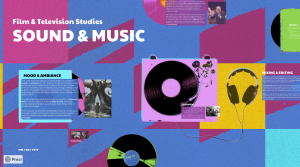27 Sound and Music
Learning Objectives
-
Explore the use of sound and music in film to provoke psychological and emotional responses from audiences.
-
Use metacognitive reading strategies before, during and after reading fiction, non-fiction and graphics.
Chapter & Discussion
This chapter includes a presentation that can be navigated in a classroom setting or independently. You can access the presentation via the link below.
Sound and Music Design in Film
Work through the different sections of the chapter and discuss ideas and topics as they arise. If you’re working independently, take notes instead. Notes and active discussion will be helpful in navigating this week’s assignments.
Overview
Sound and music are extremely important to the filmmaking process. These elements can have a major impact on a film’s ambience, inform the story, convey emotion, shape audience expectations, and work in tandem with visuals to create meaning. When done thoughtfully, sound design can profoundly and subconsciously enhance the film experience.
We use the term sound design to refer to the sound recording, editing, and the development and selection of music for films. There are a lot of different roles in the sound design process and a lot of different impacts it can have on the overall film.

Mixing and Editing
Like editing, a lot of sound design for films involves trying to convince the audience that the process is invisible. There is sound all around us all the time. Sound designers try to record and recreate the ambient sound of life to provide a sense of realism for audiences as we watch.
The sound mixer balances all the audio elements like dialogue, backgrounds, and music to immerse the audience. Levels are calibrated based on objective loudness levels and subjective adjustments. Mixers utilize surround sound theater speaker setups to localize sounds and create an immersive experience.
Foley is the reproduction of everyday sound effects added to films in post-production to enhance audio quality. These are sounds that are typically synchronized with the on-screen actions, like footsteps, doors creaking, or the rustling of clothing.
Mood and Ambiance
One of the most important parts of sound design is to provide the mood and ambience of a film. These are the general atmosphere that the director wants to establish for a scene (or for the film at-large). These are intended to have emotional and psychological effects on the audience. The director might want to make you feel the vibe of a dark and stormy night, a romantic date, a car chase, or the unsettling calm before a storm.
The right ambient sounds and score music can establish an emotional tone or put the audience in a specific state of mind. Eerie music builds suspense, while warm acoustic guitar might bring a sense of comfort and nostalgia.
Internal sounds like heartbeats and flashback voices can communicate characters’ emotions and psyche in ways visuals cannot. Licensed music can establish very specific moods for special scenes like montages.

Communicating Ideas
Sound and especially music are great ways to communicate ideas in films. Music has the power to evoke and enhance emotions. By using specific musical motifs, rhythms, and melodies, composers can underscore the emotional tone of a scene, reinforcing the film’s thematic elements. For example, a melancholic melody may communicate sadness or loss, while an uplifting composition can convey joy or triumph.
Film composers often create specific musical themes associated with particular characters or ideas. These musical signatures can help communicate character traits, motivations, or changes in a character’s arc. Some sounds and music might even take on symbolism, like a ticking clock to signify that time is running out. Once we associate a theme with a particular element, the director can then use that theme for foreshadowing.
Assigned Reading
Here are this week’s readings. Additionally, please read for your own personal enjoyment for 1/2 hour each day. This will be called your “Reading Zone” reading and it will coincide with many upcoming activities.
Sound by Russel Sharman (via Moving Pictures)
Problem Set: Practice Your Skills!
Click here to complete a ten-question problem set on concepts in this chapter.
Completing problem sets like this can be an important element of independent study towards completing your HSE. I write these to resemble the style of questions you’ll find on the Reading and Language Arts GED.
Assignment: Responding to Themes in Music (250 Words)
Discuss a song with lyrics that resonates with you by answering the following questions:
-
What are some themes the artist explores? How do they explore these themes?
-
How does the music itself impact what the artist has to say (or how they say it)?
-
What’s interesting in the song? Why?
-
Pick a quote from the song and explain how it helps the author say what they have to say
Please comment on someone else’s response.
Assignment: Reading Zone Response (250 Words)
For Reading Zone, you must find a novel that is interesting to you and enjoyable to read. If you need help finding a Reading Zone book, please ask. Please read your Reading Zone book for a half-hour each day. On class days, there will be time in class dedicated to reading.
Create a response to this week’s reading that addresses the following prompts:
-
In one paragraph, summarize what you’ve read this week
-
In a second paragraph, tell me about the descriptive passages in your book. How does the author do their world-building? Do they evoke other senses than sight?
Attributions
Sharman, R. Moving Pictures. University of Arkansas Libraries Open Educational Materials. 2020.
Willems, P.H. How to Analyze Movies. Nebula. Jan 30, 2023.


